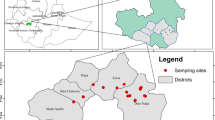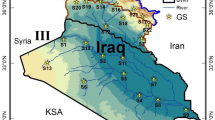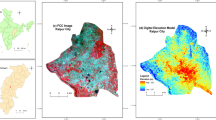Abstract
Brahmaputra is the largest river in India, and it flows through the state of Assam over a length of 916 km. The river causes flood in many places in the valley along its length during monsoon season. Among many flood prone areas in Assam, the district of Morigaon is one of the frequently flood affected districts in the state, where flood is primarily caused by the overflow of river water in the Brahmaputra. Monitoring of these flooding events using conventional optical remote sensing methods is often not feasible due to cloud cover over these regions, throughout the entire monsoon season. Hence, passive microwave remote sensing is used in the present work for monitoring the changes in the expanse of river water over the Brahmaputra near Morigaon district. As discussed in the paper, polarization index (PI) derived from passive microwave brightness temperature in X-band acts as an indicative parameter for monitoring the river water expanse and flooding in the region. A threshold value of the average PI measured over an optimum number of pixels bordering the river can indicate flood occurrences accurately and hence can be used to monitor flood in the region as explained in the paper.

(Sources: www.mapsofindia.com and google maps)

(Map source: https://bhuvan-app1.nrsc.gov.in)




Similar content being viewed by others
References
Bindlish, R., Crow, W. T., & Jackson, T. J. (2009). Role of passive microwave remote sensing in improving flood forecasts. IEEE Geoscience and Remote Sensing Letters, 6(1), 112–116.
Crow, W. T., Bindlish, R., & Jackson, T. J. (2005). The added value of spaceborne passive microwave soil moisture retrievals for forecasting rainfall–runoff partitioning. Geophysical Research Letters, 32(18), 1–5.
De Groeve, T. (2010). Flood monitoring and mapping using passive microwave remote sensing in Namibia. Geomatics, Natural Hazards and Risk, 1(1), 19–35.
De Groeve, T., & Riva, P. (2009). Global real-time detection of major floods using passive microwave remote sensing. In Proceedings of the 33rd international symposium on remote sensing of environment, Stresa, Italy.
Du, Y., Ulaby, F. T., & Dobson, M. C. (2000). Sensitivity to soil moisture by active and passive microwave sensors. IEEE Transactions on Geoscience and Remote Sensing, 38(1), 105–114.
Ellingson, S. W., & Johnson, J. T. (2006). A polarimetric survey of radio-frequency interference in C- and X-bands in the continental United States using WindSat radiometry. IEEE Transactions on Geoscience and Remote Sensing, 44(3), 540–548.
Engman, E. T., & Chauhan, N. (1995). Status of microwave soil moisture measurements with remote sensing. Remote Sensing of Environment, 51(1), 189–198.
Entekhabi, D., et al. (2010). The soil moisture active passive (SMAP) mission. Proceedings of the IEEE, 98(5), 704–716.
http://www.india-wris.nrsc.gov.in/wrpinfo/index.php?title=Brahmaputra.
http://www.mapsofindia.com/my-india/government/why-india-cant-afford-to-ignore-assam-flood-situation.
https://www.thethirdpole.net/2013/07/15/brahmaputra-tributaries-flood-india-bangladesh/.
Jackson, T. J. (1993). III. Measuring surface soil moisture using passive microwave remote sensing. Hydrological Processes, 7(2), 139–152.
Jackson, T. J., & Le Vine, D. E. (1996). Mapping surface soil moisture using an aircraft-based passive microwave instrument: Algorithm and example. Journal of Hydrology, 184(1–2), 85–99.
Jackson, T. J., & Schmugge, T. J. (1989). Passive microwave remote sensing system for soil moisture: Some supporting research. IEEE Transactions on Geoscience and Remote Sensing, 27(2), 225–235.
Jackson, T. J., et al. (1995). Large area mapping of soil moisture using the ESTAR passive microwave radiometer in Washita’92. Remote Sensing of Environment, 54(1), 27–37.
Jackson, T. J., et al. (1999). Soil moisture mapping at regional scales using microwave radiometry: The Southern Great Plains Hydrology Experiment. IEEE Transactions on Geoscience and Remote Sensing, 37(5), 2136–2151.
Jin, Y. Q. (1999). A flooding index and its regional threshold value for monitoring floods in China from SSM/I data. International Journal of Remote Sensing, 20(5), 1025–1030.
Kerr, Y. H., et al. (2001). Soil moisture retrieval from space: The Soil Moisture and Ocean Salinity (SMOS) mission. IEEE Transactions on Geoscience and Remote Sensing, 39(8), 1729–1735.
Lacava, T., et al. (2005). Improving soil wetness variations monitoring from passive microwave satellite data: The case of April 2000 Hungary flood. Remote Sensing of Environment, 96(2), 135–148.
Mizuochi, H., et al. (2018). Monitoring of an Indonesian tropical wetland by machine learning-based data fusion of passive and active microwave sensors. Remote Sensing, 10(8), 1235.
Njoku, E. G., & Entekhabi, D. (1996). Passive microwave remote sensing of soil moisture. Journal of Hydrology, 184(1-2), 101–129.
Njoku, E. G., & Li, L. (1999). Retrieval of land surface parameters using passive microwave measurements at 6–18 GHz. IEEE Transactions on Geoscience and Remote Sensing, 37(1), 79–93.
Owe, M., de Jeu, R., & Walker, J. (2001). A methodology for surface soil moisture and vegetation optical depth retrieval using the microwave polarization difference index. IEEE Transactions on Geoscience and Remote Sensing, 39(8), 1643–1654.
Paloscia, S., et al. (2001). A multifrequency algorithm for the retrieval of soil moisture on a large scale using microwave data from SMMR and SSM/I satellites. IEEE Transactions on Geoscience and Remote Sensing, 39(8), 1655–1661.
Parinussa, R. M., et al. (2016). A new framework for monitoring flood inundation using readily available satellite data. Geophysical Research Letters, 43(6), 2599–2605.
Rahman, M., et al. (2019). Rapid flood progress monitoring in cropland with NASA SMAP. Remote Sensing, 11(2), 191.
Temimi, M., et al. (2005). Flood monitoring over the Mackenzie River Basin using passive microwave data. Remote Sensing of Environment, 98(2), 344–355.
Temimi, M., et al. (2007). Flood and soil wetness monitoring over the Mackenzie River Basin using AMSR-E 37 GHz brightness temperature. Journal of Hydrology, 333(2), 317–328.
Wang, J. R., & Choudhury, B. J. (1981). Remote sensing of soil moisture content, over bare field at 1.4 GHz frequency. Journal of Geophysical Research: Oceans, 86(C6), 5277–5282.
Author information
Authors and Affiliations
Corresponding author
Additional information
Publisher's Note
Springer Nature remains neutral with regard to jurisdictional claims in published maps and institutional affiliations.
About this article
Cite this article
Goswami, B., Kalita, M. Monitoring of Brahmaputra Flood Using Passive Microwave Remote Sensing in Morigaon District of Assam, India. J Indian Soc Remote Sens 47, 1633–1641 (2019). https://doi.org/10.1007/s12524-019-01010-9
Received:
Accepted:
Published:
Issue Date:
DOI: https://doi.org/10.1007/s12524-019-01010-9





